Roof spill systems: existing types of systems and their arrangement + calculation and installation steps
Significantly reduce the load from precipitation on the facade, blind area and foundation allow roof drainage systems built along the slopes of gable roofs or along the perimeter of four-gated structures. In order for the drainage complex to be effective, it is necessary to select the material and calculate the parameters of the component parts.
We will talk about how to choose a gutter system depending on the technical data and features of the house. The article we presented describes in detail the calculation steps and the installation technology for the removal of atmospheric water. Based on our advice, you can do the whole front of the work yourself.
The content of the article:
Classification of drainage systems
The principle of organizing the removal of melt and rainwater depends on a number of factors: the roof structure, the climatic conditions of the region, and the personal preferences of the owner of the house. In any case, the gutter should operate efficiently all year round without the appearance of deciduous, ice plugs or dusty blockages.
When planning a spillway, it is necessary to determine the important parameters: the location and configuration of the system, as well as the material for manufacturing the constituent elements.
External and internal drainage
A type of drainage system is selected depending on the type of roof, number of storeys of the building, as well as the weather conditions of the area.
In the arrangement of houses using three options for sanitation:
- outdoor unorganized;
- outdoor organized;
- internal organized.
The first type involves spontaneous runoff of water.For work, it is enough to bring the cornice at an angle outside the wall.
A gravity system is infrequently made in residential buildings due to a number of shortcomings. Water falls near the foundation, increasing the likelihood of its destruction.
Features of the arrangement of an unorganized drain:
- the amount of annual precipitation in the region should not exceed 300 mm / year;
- the roof must be equipped with a visor 60 cm or more in length;
- on the side of the house where the slope faces, it will not be possible to equip a balcony, and there should not be a pedestrian zone.
The most popular system for private homes is the outdoor organized variety. This option is suitable for broken, gable, tent, hip roofs. For the subsequent removal of moisture equip filter well or storm sewer.
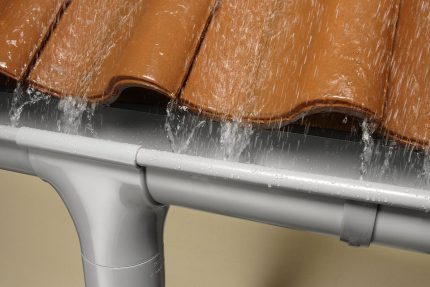
Specificity of external type drains:
- work well in warm regions, in areas with frosty winters it is advisable to provide an anti-icing system;
- in cold storage facilities, the probability of ice plugs is minimized - here you can equip an external drain without heating.
The internal system involves the installation of a drainage pipe inside the building. The complex works effectively at positive and negative street temperatures. Such a spillway is usually equipped in shopping centers, high-rise buildings with a flat or pitched roof.
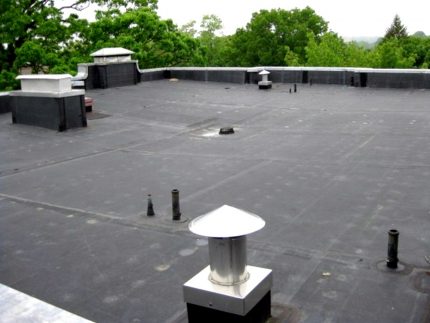
Based on the design features, there are two types of internal systems:
- Gravity. Water flows freely through inclined troughs. Designing a system is straightforward, an additional plus is its affordable cost.
- Siphon. Precipitation accumulates, fills the pipe from the funnel to the sewer outlet. When the liquid level decreases, a discharge zone is formed - water is literally absorbed.
The siphon system is more expensive in arrangement, however, when installing it, you can use the minimum number of funnels and pipes of reduced diameter. Siphon gutter copes with heavy rainfall. An additional plus is self-cleaning under the pressure of flowing water.
Closed and open systems
The type of roof determines the configuration and specifics. installation of a drainage system. For a house with a gable roof, it is enough to install two straight gutters and vertical drain pipes.
If the roof slope is of a non-standard configuration, then to create an effective system and preserve the aesthetic appearance of the house, you will have to develop a more complex complex.
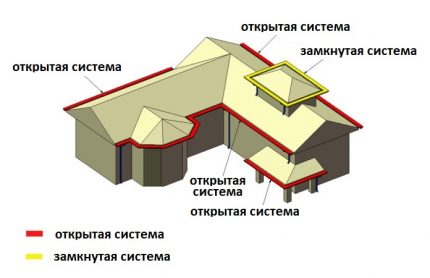
The drainage from the hip roof is carried out in different directions, so the vertical drain pipes must be installed in the corners of the building. The calculation of the closed system is performed taking into account the total area of the roof.
In gable, multi-slope and multi-slope structures, several separate gutter lines are installed. Drainage vertical channels are placed in the center of the wall or at the corners of the house.
Waterdrop manufacturing materials
Elements of the drainage system are made of metal or plastic. There is also a combined version - metal products with a polymer coating. Each material has pros and cons.
Among the metal gutters used:
- steel;
- aluminum;
- copper.
Galvanized steel gutters are affordable, durable, resistant to temperature extremes and UV rays.
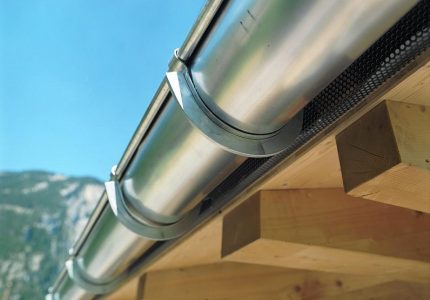
To improve the appearance and extend the life of the drain, galvanization is coated with polymers.
Possible options:
- Pural. The surface is resistant to mechanical damage, UV rays. Service life - 30-35 years. Pural products are more expensive than other composite elements.
- Plastisol. PVC coating is affordable and has a variety of colors. A significant minus is the fear of sunlight, the polymer is deformed under the influence of ultraviolet radiation. The gutter made of steel and plastisol is suitable for northern, mostly cloudy regions.
- Polyester. The coating is not afraid of the sun, but sensitive to mechanical damage - scratches appear. Service life - up to 10-15 years. Deformation of the protective layer leads to the gradual destruction of the steel base.
Drains made of metal with a polymer coating are suitable for roofs made of metal. The durability of the materials is approximately the same - it will be possible to replace at the same time.
Copper spillways look prestigious and practical in operation. Over time, the structure becomes covered with a patina and does not oxidize. The disadvantages of copper systems are the high cost and severity.
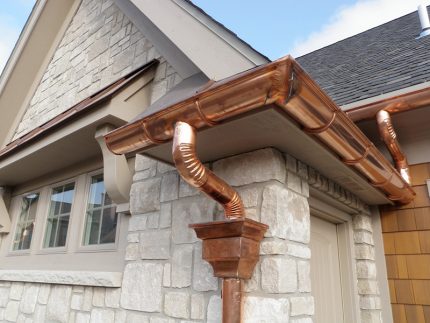
Plastic gutter options are in great demand in private housing construction. Comparison of plastic and metal systems given hereWe recommend that you familiarize yourself with useful information.
Among their main advantages note:
- good value for money - plastic products are more expensive than galvanized elements, but cheaper than others;
- the ability to choose colors for the exterior of the house;
- good sound absorption;
- anticorrosive qualities;
- ease of installation.
Plastic drainage systems are quite fragile. They are particularly susceptible to mechanical damage at sub-zero temperatures. To reduce the risk of damage to the gutter due to the abundance of rainfall, snow retainers should be installed on the roof.
Typical roof drainage
Different manufacturers offer a standard set of elements of the drainage system. They may differ in size, material of manufacture and appearance. The system includes horizontal gutters installed under the edge of the roof covering, and downpipes connected to the gutters by drainage funnels.
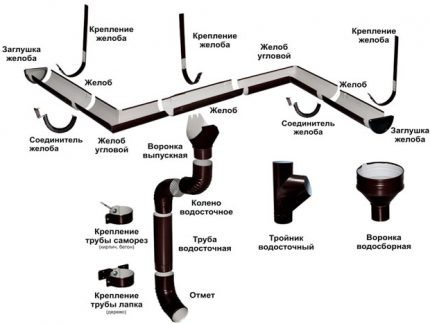
The composition of the system is compiled depending on the configuration of the drainage system.
Gutter and connecting elements for it
Semicircular gutter - a tray for collecting, removing rainfall from the roof. The cross section of the gutter is an open semi-circular or angular shape. Design is selected for the architecture of the building. The size of the tray should match the expected load. The latter in turn depends on the area of the roof.
Gutter rotation used to change the drain line. The standard angle is 90 °, but there are also products with a parameter of 135 °.
When mounting a turn, they are guided by the rules:
- joints of corners and gutters must be sealed with glue or rubber seals;
- the distance from the ends of the turn to the brackets should be no more than 10-15 cm - in these places the strength of the system is lower.
Gutter connector - a semicircular strip with clamps and latches. The element is used to dock the gutters in a solid line. A rubber seal is required to seal the joint.

Mounting brackets. The choice of a specific model depends on the technology. gutter installations, the location of the main elements and the stage of repair / construction.
Possible hook brackets:
- Long. It is used to fix the drainage system to the roof covering. Elements are attached to the rafters, as a rule, even before the installation of the crate.
- Short. Suitable for installing gutters on a building wall or windshield. Hooks can be mounted even before the roofing is placed or after the roof has been arranged.
- Universal. Collapsible elements used before or after flooring of the roofing material. The length of the universal hooks can be adjusted.
Stub mounted on the end of the gutter. Latches are provided for reliable fixation, and a rubber gasket is used to increase the tightness of the connection. The design, as a rule, is universal - the plug is suitable for the right and left edges of the tray.
Discharge Line Elements
Catchment funnel suitable for areas where it is not possible to mount a conventional spillway system. It is applicable for roof arches with complex architectural forms. A drain pipe is directly connected to the catchment funnel.
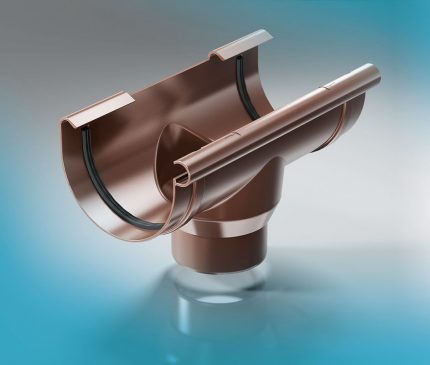
Knee Is an element that is necessary to change the direction of the drainpipe, i.e. pipe bypass near the architectural ledges of the building.
Drain pipe it is intended for arrangement of a vertical sewage pipeline. The diameter of the element is selected based on the debit of the water, the typical length is 3 m.

Mark - bent tip. It is mounted at the bottom of the drainpipe to drain water from the foundation and basement of the building.
Pipe holders - These are clamps for fastening vertical pipes to the wall. Holders are made of plastic and metal. Fasteners must withstand the load on the gutter and be less visible.
Gutter system calculation algorithm
For the effective work of water disposal, it is not so important what material the system is assembled from, how important it is to select the optimal technical parameters of its components. It is important to determine the diameters of pipes and gutters, to calculate the number of turns, connections and other additional elements.
Stage # 1 - data collection for calculations
First of all, they measure the parameters of the building. It is better to take measurements manually, as the data of technical documentation may be somewhat distorted.
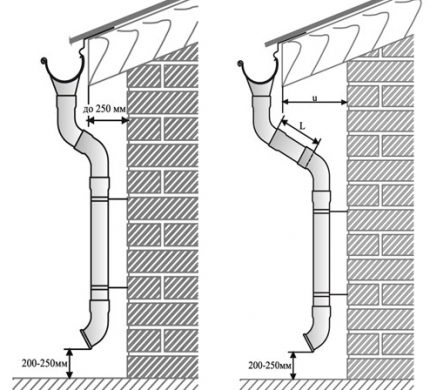
On paper, you need to make a sketch showing all the roof slopes. On the diagram indicate the length of the cornice for each element where the gutter will be placed. The next step is to determine the area of the slopes, the calculation is carried out according to the appropriate formulas of geometric figures.
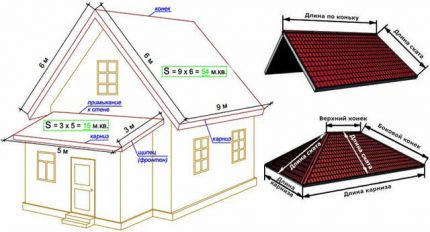
You can navigate according to the roof plan and choose the largest slope for calculation.
Stage # 2 - determination of the diameter and number of pipes
According to the standards, when calculating the cross section of the trays and drainpipes, it is necessary to take into account the angle of inclination of the roof. However, in practice, they often repel only from the area of the ramp.
The number of gutters is determined by the sketch of the roof.It is enough to measure the length of the eaves and plan the places of the joints of the trays.
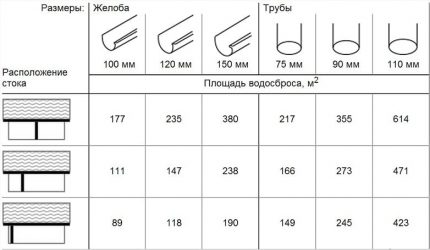
It is more difficult to calculate the number of vertical bends.
The following rules should be followed:
- on a line with a length of 10 m and less - 1 drain;
- if the length of the gutter exceeds 12 m - 2 branches;
- for roofs of complex shape, additional gutters must be provided for each ledge;
- on the line with a plug - 1 tap.
Two short sections located nearby, it is advisable to connect in one riser using a splitter.
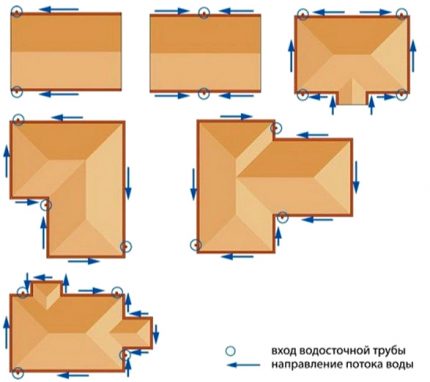
On large slopes, the distance between the spillway pipes should not be more than 24 m.
Stage # 3 - calculation of additional system elements
After determining the configuration of the drainage system, the length and number of joints of the gutters, the flow rate of minor details is determined:
- Stubs. The sketch calculates the number of open ends. For each open line, 2 plugs are required.
- Connectors. The number of couplings depends on the presence of gutter joints. The calculation is carried out for individual lines according to the formula: the number of trays minus one.
- Funnels and tees. The number of transition elements is selected individually according to the scheme of the drainage system. For each vertical pipe there is one funnel.
The number of brackets for attaching the gutters depends on the type of retainer and the length of the cornices.
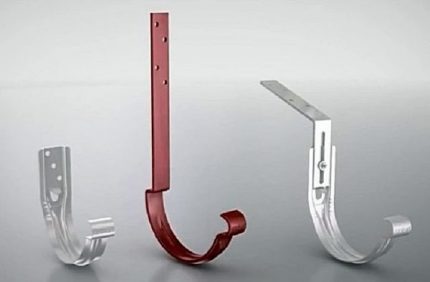
To calculate the number of short brackets, use the formula:
N = (L-30) / 60,
Where:
- N - desired value;
- L - the length of the gutter in centimeters.
The calculation is carried out separately for each line.
Stage # 3 - Vertical Retraction Calculation
It will be necessary to calculate: the length of the pipe, the number of connectors and clamps-holders. In addition, it is necessary to determine the organization of moisture removal.
Pipe length calculation:
- Measure the distance from the blind area to the edge of the roof.
- Subtract the transition height from the obtained value - bends from the funnels connecting the tray to the pipe. This section may include: elbow, connecting piece of pipeline.
- The height of the elevation and the distance to the ground should be subtracted from the calculated length - about 20-25 cm.
The number of connectors equals the number of joints. For example, for an outlet of 6 m, 2 drains of 3 m and 2 couplings are required. One element is docking with a funnel, the second is pipe fixing.
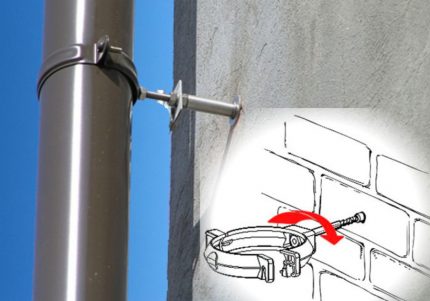
Fasteners 10 cm long are suitable for the plastered walls. For an insulated facade, the size of the screw is increased by the thickness of the insulating material.
Spillway mounting technology
The exact configuration of the necessary tools depends on the material of the gutters.
In any case, you will need:
- hammer drill;
- screwdriver;
- level, plumb line;
- tape measure, pencil, cord;
- pliers;
- ladder;
- hammer, mallet.
Workflow for installation of a spillway system can be divided into three main stages.
Correct Bracket Installation
When mounting brackets, the procedure is as follows:
- Marks are made at the corners of the slopes, indicating the places of the extreme brackets.
- The first bracket is fixed to the windshield.
- An extreme hook is installed on the back of the carrier base, maintaining the necessary slope of 3-5 mm per 1 m.
- Between the brackets pull the cord and set the intermediate elements in a line.
After placing the hooks, the rope must be removed.
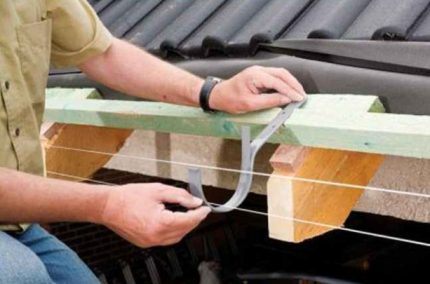
Gutter system
Installation is best to start from the place where the vertical spillway will be connected. In the gutter, it is necessary to make a hole for the funnel with a hacksaw for metal, to process the edges. Install the adapter between horizontal and vertical elements will be obtained using connectors.
Following actions:
- Put on the end cap on the end tray.
- Lay the gutters alternately in the brackets, withstanding overlapping elements of 5-10 cm.
To ensure better sealing, rubberized connectors should be worn at the joints.
Installation of vertical risers
The installation of risers begins with the installation of clamps. To do this, a vertical line is lowered from the funnel by a plumb line, beat off on the wall.
Be sure to provide clamps near the junction of the drainpipes, the maximum distance to the fasteners is 10 cm.
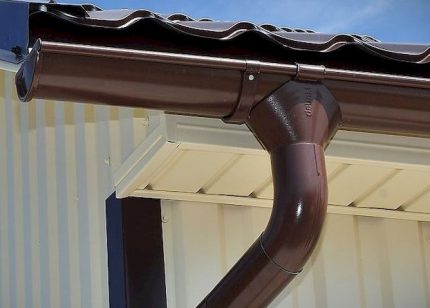
Then mount the additional elements, connect the vertical and horizontal bends to each other, set the lower mark. In regions with heavy winter rainfall, it is desirable to equip the drainage system heating circuit, installation instructions are described in our recommended article.
Conclusions and useful video on the topic
Determination of roof parameters and calculation of downspouts:
Step-by-step instruction on the arrangement of a roof drainage system for a private house:
In principle, the calculation procedure and installation technology of the drainage system is quite simple. To cope with the task is quite realistic on their own. Experienced craftsmen equip roof drainage in one day, more time will be taken from a novice master.
Please write comments in the block below, post a photo on the topic of the article, ask questions. Tell us about how you calculated the material consumption for the device of the drainage system and installed its elements. Share useful information and technological subtleties.

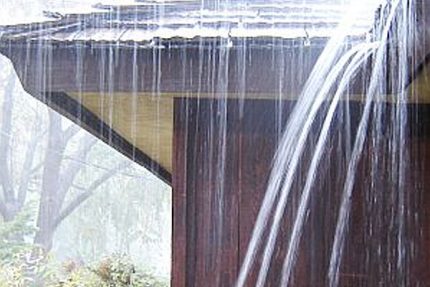
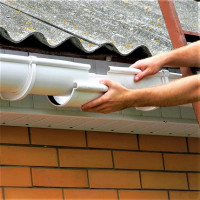 Installation of a gutter system: the main stages of self-installation of gutters
Installation of a gutter system: the main stages of self-installation of gutters 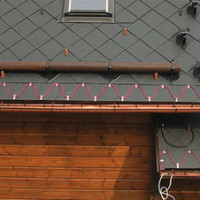 Gutter heating: do-it-yourself installation of a roof and gutter heating system
Gutter heating: do-it-yourself installation of a roof and gutter heating system 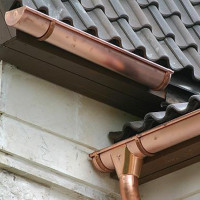 Do-it-yourself installation of metal gutters for the roof: technology analysis + installation example
Do-it-yourself installation of metal gutters for the roof: technology analysis + installation example 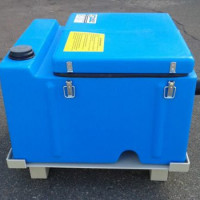 Grease traps for sewers: types, selection rules + installation procedure
Grease traps for sewers: types, selection rules + installation procedure 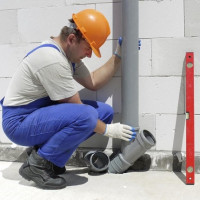 Wiring of sewers in a private house: drawing up a diagram and a project + stages of work
Wiring of sewers in a private house: drawing up a diagram and a project + stages of work 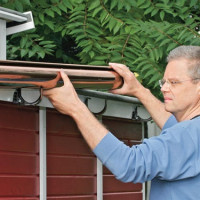 Installation of gutters: how to properly install the gutter and attach it to the roof
Installation of gutters: how to properly install the gutter and attach it to the roof  How much does it cost to connect gas to a private house: the price of organizing gas supply
How much does it cost to connect gas to a private house: the price of organizing gas supply  The best washing machines with dryer: model rating and customer tips
The best washing machines with dryer: model rating and customer tips  What is the color temperature of light and the nuances of choosing the temperature of the lamps to suit your needs
What is the color temperature of light and the nuances of choosing the temperature of the lamps to suit your needs  Replacement of a geyser in an apartment: replacement paperwork + basic norms and requirements
Replacement of a geyser in an apartment: replacement paperwork + basic norms and requirements
I would recommend when installing vertical risers, when it will be necessary to mount the clamps near the pipe joints, do not risk and do not resort to the maximum distance to the fasteners of 10 cm. In my opinion, the optimal distance interval will be half as much as 5 cm. This will allow provide a more durable and reliable mount. In general, I agree with what is mentioned above. The spillway system, built around the perimeter of the house, significantly protects the facade and foundation of the house.
I have the following situation - there is a house sheathed with siding. Will it be possible to install a gutter system on it? And is it needed at all in this case? Foundation of a pile-screw house.
Hello. In general, it was advisable to hang fasteners before sheathing, of course. But they are mounted after. For example, fasten brackets to the chamfer of the windshield.In order not to stiffly stiff the siding and leave the strain relief, you can make holes a little larger for the anchor fasteners and use the sleeve for fixing.
It happened to see (but in practice not used by me), even special drainage systems that are sold in the assembly for ready-made siding.
Do not forget to make also a storm-water drainage system from the foundation.